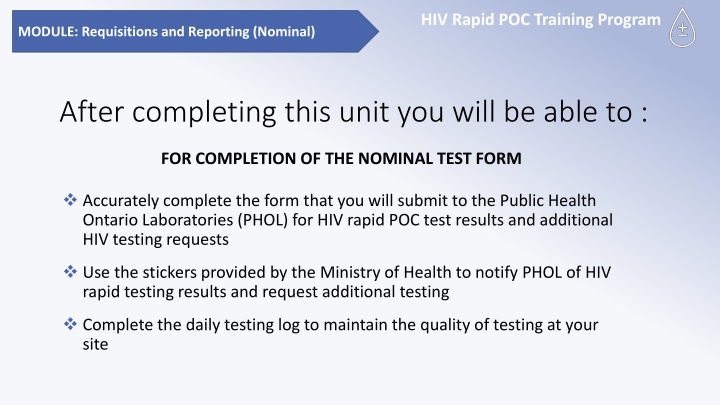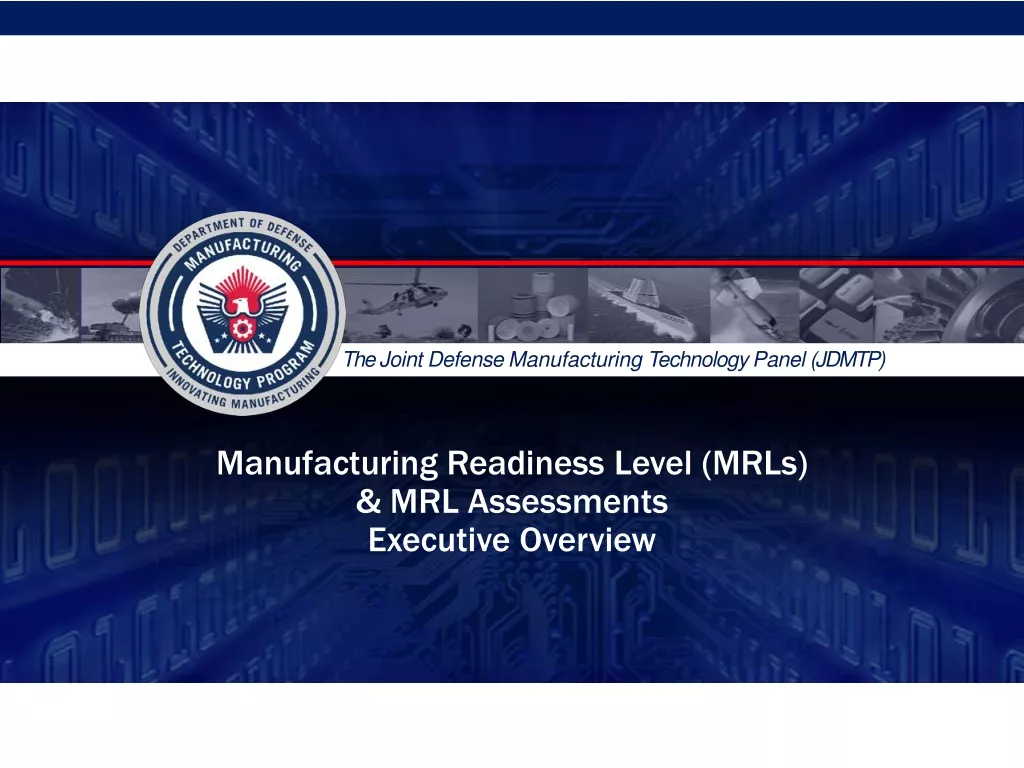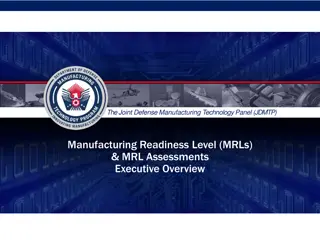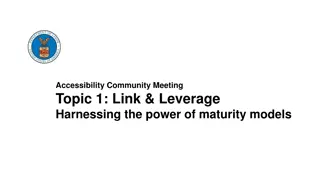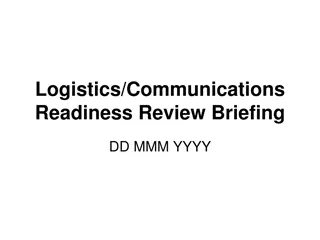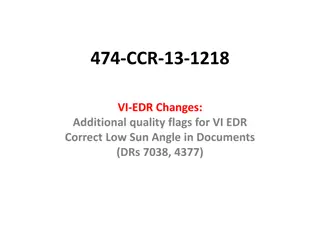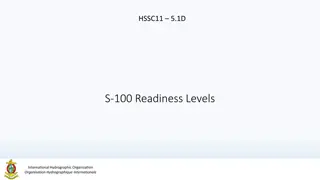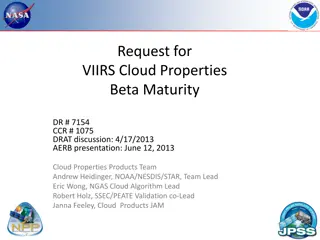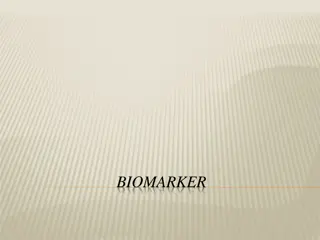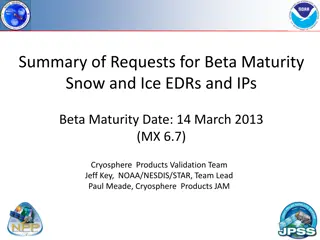Science Maturity Readiness Review for Surface Type EDR
This review delves into the validated Stage 1 Science Maturity Readiness for Surface Type EDR, as presented by Xiwu Zhan. It covers an algorithm overview, team members, previous validation results revisited, performance evaluation, required inputs effect evaluation, quality flag analysis, error budget, processing environment identification, user feedback, and the path forward. The Surface Type EDR team comprises individuals from NOAA/STAR, UMD/Geography, and BU/Geography leading various tasks to deliver the product.
Download Presentation

Please find below an Image/Link to download the presentation.
The content on the website is provided AS IS for your information and personal use only. It may not be sold, licensed, or shared on other websites without obtaining consent from the author.If you encounter any issues during the download, it is possible that the publisher has removed the file from their server.
You are allowed to download the files provided on this website for personal or commercial use, subject to the condition that they are used lawfully. All files are the property of their respective owners.
The content on the website is provided AS IS for your information and personal use only. It may not be sold, licensed, or shared on other websites without obtaining consent from the author.
E N D
Presentation Transcript
HIV Rapid POC Training Program MODULE: Requisitions and Reporting (Nominal) After completing this unit you will be able to : FOR COMPLETION OF THE NOMINAL TEST FORM Accurately complete the form that you will submit to the Public Health Ontario Laboratories (PHOL) for HIV rapid POC test results and additional HIV testing requests Use the stickers provided by the Ministry of Health to notify PHOL of HIV rapid testing results and request additional testing Complete the daily testing log to maintain the quality of testing at your site
HIV Rapid POC Training Program MODULE: Requisitions and Reporting (Nominal) Record Keeping is Essential Every time you do an POC HIV test for a client, you MUST: Complete an HIV Serology Requisition form. These can be downloaded from https://www.publichealthontario.ca/ Make a log entry for the test on your site s daily log These record-keeping steps are essential to provide accurate results for your clients and to maintain quality standards at your testing site. Errors in this record keeping would be an incident that requires an investigation at your site. Ultimately effective record-keeping is necessary to maintain approval for testing at your site.
HIV Rapid POC Training Program MODULE: Requisitions and Reporting (Nominal) HIV Serology Requisition This form is used when a client is requesting: Rapid POC testing done at your site Laboratory testing from the Public Health Ontario Laboratory (PHOL) Whenever you do a valid POC test, you must submit a form to PHOL. Be sure to complete the form and all of its fields in full. You only submit ONE form for each client, even if you are reporting a POC test result and requesting a follow-up test for confirmation or further window period screening.
HIV Rapid POC Training Program MODULE: Requisitions and Reporting (Nominal) Anonymized forms In this module, we will discuss several scenarios that may occur when submitting a serology form to PHOL. Sometimes you will submit a form, but not a sample. This happens when: You did a POC test and it was nonreactive; there is no reason to request further follow-up testing There is a reason to recommend follow-up testing, but your client does not consent to submit a specimen to PHOL In these circumstances, your client should not be identified to PHOL, and information like the client s name and date of birth should be excluded from the form (an anonymized form). However you must still submit a record of the test and information about the reason for the test and the client s risk factors.
HIV Rapid POC Training Program MODULE: Requisitions and Reporting (Nominal) Workflow and the Serology Requisition Complete all sections as fully as possible. Complete the sections: Reason for testing Previous testing information Race/Ethnicity Risk factors while speaking with your client, during the HIV testing counselling appointment Do not complete the patient information section of the form until POC testing is complete. The outcomes of the POC testing will determine whether or not you need to anonymize this information.
HIV Rapid POC Training Program MODULE: Requisitions and Reporting (Nominal) The Serology Requisition Your clinic will most often have pre-printed HIV Serology forms with this portion complete. If you need to complete it by hand, the doctor s name is the person who holds your site s medical directive and their CPSO# is used. Where do you get forms when you need them (or more when you run out)? Ask about the practice at your site.
HIV Rapid POC Training Program MODULE: Requisitions and Reporting (Nominal) Required Fields Most tests will be routine although you may identify additional reasons for testing, such as sexual assault or symptoms of acute HIV infection, when speaking with the client. x Complete this section based on your site s records of this client OR what the client tells you about their history. This information is often collected on your site s intake form. Some sites are able to print this information from their electric medical record as part of the patient identification sticker.
HIV Rapid POC Training Program MODULE: Requisitions and Reporting (Nominal) Required Fields Collected during your risk assessment of the client All required sections of the form are important for provincial planners to understand where more HIV prevention and care services are needed. They are not used to track individual patients.
HIV Rapid POC Training Program MODULE: Requisitions and Reporting (Nominal) Do not complete the patient information section of the form until POC testing is complete. When Submitting a Sample Be careful to enter the client s OHIP card number correctly and their full date of birth. This information is used by Public Health units to follow-up with clients for contact tracing. Make sure that the specimen details are complete. The tube of blood and the form must have the date you drew the blood. Both this date and the person s name must MATCH. You will usually be submitting serum (red top tube) and requesting a HIV1/HIV2 test X X
HIV Rapid POC Training Program MODULE: Requisitions and Reporting (Nominal) When NOT Submitting a Sample If only POC testing was done, the patient information should be limited. If you are not submitting a sample to PHOL: Only put the client s year of birth on the form Don t use the client s name, use an identification code Suggested code If you saw Jack Smith on July 3, 2019, the code could be: JS-03072019 Your site will order stickers from the Ministry to flag forms that are not submitted with samples. We will review the sticker system, as we review possible testing scenarios.
HIV Rapid POC Training Program MODULE: Requisitions and Reporting (Nominal) Testing Scenarios Here are some scenarios you will encounter when testing clients : 1) Your client requests standard testing (You did not do a rapid test.) 2) You perform a rapid POC test - it is non-reactive and outside the window period. 3) You perform a rapid POC test and it is non-reactive. However, the client is from a priority population, has had a very recent high risk exposure (in the last 2-4 weeks or with current signs of acute HIV infection). 4) You perform a rapid POC test and it is reactive. 5) Your client has two invalid POC tests, and you are submitting a sample for testing.
HIV Rapid POC Training Program MODULE: Requisitions and Reporting (Nominal) 1) Standard Testing Some of your clients will choose to have a standard HIV test instead of a rapid test. After counselling and consent: Draw and label a tube of blood (red top tube) Complete the form fully, including the client s name and OHIP# Ensure that the name and date on the sample matches the name and date on the form. No Sticker necessary Submit the tube and requisition; enter the test on the daily log if this is the practice at your site. Book an appointment in approximately one week for the client to return for their result.
HIV Rapid POC Training Program MODULE: Requisitions and Reporting (Nominal) 2) A Non-reactive POC Test After counselling and consent: You perform a POC test; it is non-reactive and the client is not in the window period Complete the patient information section using a code (not the client s name) and their year of birth; attach a GREEN non- reactive sticker Submit the requisition and enter this test on the daily log X Complete post-test counselling. Advise client about further testing (follow-up testing on a high risk exposure or routine testing.) NOTE: PHOL will issue a standard report for this submission, it can be discarded.
HIV Rapid POC Training Program MODULE: Requisitions and Reporting (Nominal) 3) A Non-Reactive Window Period Test After counselling and consent, you determine that: The client is from a priority population and has had a very recent high risk exposure (in the last 2-4 weeks or with signs of acute HIV infection). Perform a POC test; it is non-reactive Recommend the client submit a standard test for p24 testing; if the client agrees, draw blood Complete the form fully, including the client s name and OHIP#; attach a YELLOW non-reactive window period sticker; ensure the name/date on the sample matches the name/date on the form Submit the requisition; enter the test on the daily log Complete post-test counselling. Book an appointment in one week to share results.
HIV Rapid POC Training Program MODULE: Requisitions and Reporting (Nominal) 4) A Reactive POC Test After counselling and consent: Perform a POC test; it is reactive Recommend client submit a standard test to confirm this result; if the client agrees, draw blood Complete the form fully, including the client s name and OHIP#; attach a PINK reactive sticker. Ensure the name/date on the sample matches the name/date on the form Submit the requisition; enter the test on the daily log Complete post-test counselling. Book an appointment in one week to confirm result.
HIV Rapid POC Training Program MODULE: Requisitions and Reporting (Nominal) 5) Two repeated Invalid tests After counselling and consent: Perform a POC test; it is invalid. Repeat the test once; ensure a sufficient sample of blood. If is invalid again, don t throw out the test membranes. If TWO invalid tests have occurred, ask the client if you can draw blood for standard testing. Be reassuring, an invalid result, is not caused by the presence of HIV. It can have many underlying causes (most commonly adding too little sample to the test.) If the client agrees, draw blood (red top) for testing. Ensure the form is completed fully for standard testing; no sticker is needed. If the client declines standard testing, DO NOT SUBMIT A FORM as a valid test did not occur. Enter the record of both POC and standard tests on the daily log as well as an entry in the incident log for the invalid tests. Take a picture of the invalid membranes and notify the AIDS Bureau about the invalid tests. No Sticker necessary Complete post-test counselling. Book an appointment in one week for results.
HIV Rapid POC Training Program MODULE: Requisitions and Reporting (Nominal) Forms without Samples What Sticker do I use? The purpose of the priority stickers is to clarify for PHOL staff what further actions to take. When you submit a form to PHOL but NOT a blood sample, you need to make it clear that a sample has not been lost. The most usual no sample situation is a nonreactive test , where the client is not in the window period, and no further testing is needed. Use the GREEN sticker. In other circumstances, this white sticker is added in addition to another sticker, to make it clear that a sample is intentionally absent: Client had a reactive POC test and declined blood draw (PINK + WHITE) Priority population client, had a very recent high risk exposure (3-4 weeks) and declined a blood draw (YELLOW + WHITE) Priority population client, testing six weeks after a very high risk exposure (YELLOW + WHITE) Client is NOT from a priority population and is in the window period, but has been deferred from blood draw (GREEN + WHITE) blood sample not included Forms without samples should be anonymized (no name or date of birth; use code/year of birth only)
HIV Rapid POC Training Program MODULE: Requisitions and Reporting (Nominal) Summary HIV Serology Requisition Complete the form for all POC tests add the appropriate sticker Put second white sticker here if needed blood sample not included blood sample not included
HIV Rapid POC Training Program MODULE: Requisitions and Reporting (Nominal) The Daily Log This is a screen shot of the daily log template. An entry must be made for every test you do. Make sure you sign and date each entry. This part of the log is used for follow-up of tests sent to PHOL and analysis of the returned results. This part of the log is used to make a record of any POC test.
HIV Rapid POC Training Program MODULE: Requisitions and Reporting (Nominal) The Daily Log Record of a POC Test Write the result in one of these three fields. If sending a sample to PHOL say yes in the last field, shown here. Use these four fields for every test you do: When you did the test Who you did the test for (most commonly a client name/number) The risk factors (usually abbreviated i.e. MSM, ACB, PWID, etc.) The lot number and expiry date of the kit you used For Proficiency Tests, practice testing, or errors/damage, write what the test was used for across these fields
HIV Rapid POC Training Program MODULE: Requisitions and Reporting (Nominal) The Daily Log Record of a Sample Sent to PHOL Date and sign. Say yes if a sample is sent to PHOL Record differences between POC and PHOL results. These fields may be completed by the Quality Assurance Lead at your site when preparing the monthly summary report. Ask about the practice at your site. Most commonly you will do this if the client is testing early in the window period Use the results that return to you from PHOL (1 week) to complete these fields.
HIV Rapid POC Training Program MODULE: Requisitions and Reporting (Nominal) The Daily Log Record keeping in the Daily Log matters because: It lets you track what has been sent to PHOL for testing, to ensure all sent samples have a result returned It helps track the number of test kits used at your site, a total required when ordering new kits through the Inventory Management portal (www.hivpoct.ca) The log assists with quality assurance at your site, helping to identify any discrepancies between the POC test results you record and PHOL findings
